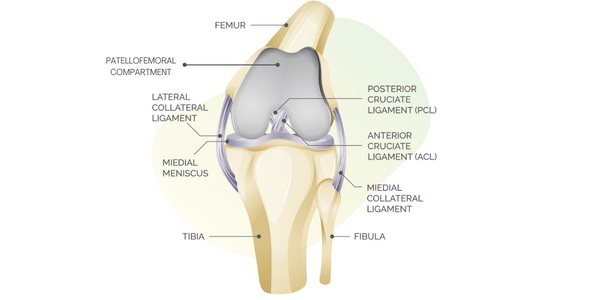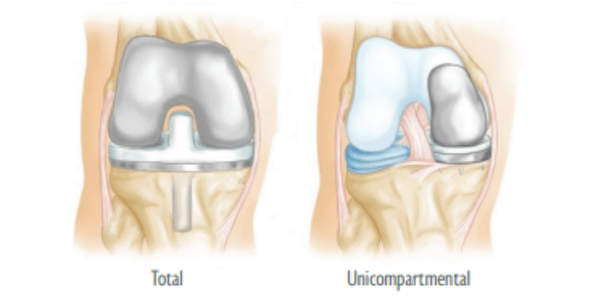Total or partial knee replacement: what’s best for me?

Knee replacement surgery is now a relatively common procedure. The average age for a knee replacement is 70, but thanks to improving technology and outcomes, an increasing number of people are choosing to have surgery at a younger age.
New national guidance for knee replacement surgery was issued in June 2020 by the National Institute for Health and Care Excellence (NICE). This was the result of an extensive review of all the available evidence and recommends that surgeons should:
‘Offer a choice of partial or total knee replacement to people with isolated medial compartmental osteoarthritis. Discuss the potential benefits and risks of each option with the person.’
Mr. Gareth G. Jones, orthopaedic surgeon, is a knee replacement specialist at the King Edward VII’s Hospital. In this article, he explains who this new guidance applies to, the difference between a partial and total knee replacement, and the pros and cons of each procedure.
Do I need knee replacement surgery?
Also called ‘arthroplasty’, a knee replacement involves relining the knee joint because the smooth cartilage covering the bones has become damaged (osteoarthritis). This commonly occurs through injury, wear and tear, or diseases such as rheumatoid arthritis.
If treatments such as pain-killers, lubricant or steroid injections, or physiotherapy do not help, then surgery might be the next option. An X-ray can reveal whether the cartilage in a knee joint has worn away completely, exposing the underlying bone – in which case knee replacement surgery would be appropriate.
What’s the difference between a partial and a total knee replacement?
In general there are three types of knee replacement: a partial knee replacement, a total knee replacement, and a patellofemoral joint replacement. To understand how they differ, it is helpful to consider that the knee joint is made up of three parts:
- The inside of the knee (nearest to the other knee) called the ‘medial compartment’
- The outside of the knee (furthest from the other knee), called the ‘lateral compartment’
- The front side of the knee under the kneecap, called the ‘patellofemoral compartment’

A total knee replacement involves replacing all three compartments of the knee joint (i.e. the medial, lateral and patellofemoral compartments). This procedure is an option when one or more compartments of the knee are damaged.
In contrast, a partial knee replacement (also known as a unicompartmental knee replacement) replaces only the damaged part of the knee i.e. the inside (medial) or the outside (lateral) compartment. The remaining two healthy compartments are preserved. This procedure can be considered if only one compartment of the knee is damaged, and the other two are normal.

A patellofemoral joint replacement is an option for patients when the damage is confined to the area under the kneecap (patellofemoral compartment). However, the new national guidelines from NICE did not explore the indications for this procedure.
What are the benefits and disadvantages of a partial knee replacement compared to a total knee replacement?
The benefits of a partial knee replacement include:
- Usually performed through a smaller skin incision
- Less pain, shorter length of hospital stay and faster recovery
- Fewer serious surgical complications such as infections, blood clots, heart attacks, stroke and death
- Better functional outcomes reported by patients
- Lower rate of early re-operations

The disadvantages of a partial knee replacement include:
- Only being suitable for patients with a single worn-out or damaged compartment of the knee (although this covers almost 50% of patients)
- Being a technically demanding operation, more consistent results are achieved when performed by dedicated specialists
- A greater chance of needing further surgery over the longer term
What are the benefits and disadvantages of a total knee replacement compared to a partial knee replacement?
The benefits of a total knee replacement include:
- Effective even when damage to the knee joint is more extensive, involving two or three compartments
- A lower chance of needing further surgery over the longer term
The disadvantages of a total knee replacement include:
- Usually a longer skin incision
- More pain, longer length of hospital stay and slower recovery
- Greater risk of serious complications such as infections, blood clots, heart attacks, stroke and death
- Worse functional outcomes reported by patients
- Higher rate of early re-operations
What accounts for the differences between total and partial knee replacements?
In general, partial knee replacement surgery is a smaller, less invasive procedure than a total knee replacement, and preserves more of the original knee.
Summary
National data collected on all knee replacements performed in the UK demonstrate a higher long-term chance of needing further surgery after a partial knee replacement. But this statistic is more nuanced than it might at first seem (which is why it continues to be debated among knee surgeons) and there are many reasons why this may be the case. For example, partial knee replacements are more likely to be offered to patients who are more active, which might in itself impact on the risk of needing further surgery.
As this article illustrates, partial and total knee replacements have their relative advantages and disadvantages. The final decision is a personal one, and best discussed with a knee replacement specialist who frequently performs both procedures.
More information
- Speak to your GP if you think you might need a knee replacement. They can refer you to the relevant specialist. (Don’t have a GP?)
- Mr Gareth Jones is an expert in partial and total knee replacement, and part of the King Edward VII’s Hospital Orthopaedic Surgery department, a world-renowned centre of excellence, staffed by dedicated doctors, nurses and specialists. Make an enquiry.
- Some of our other specialists also carry out both partial and total knee replacement procedures.










